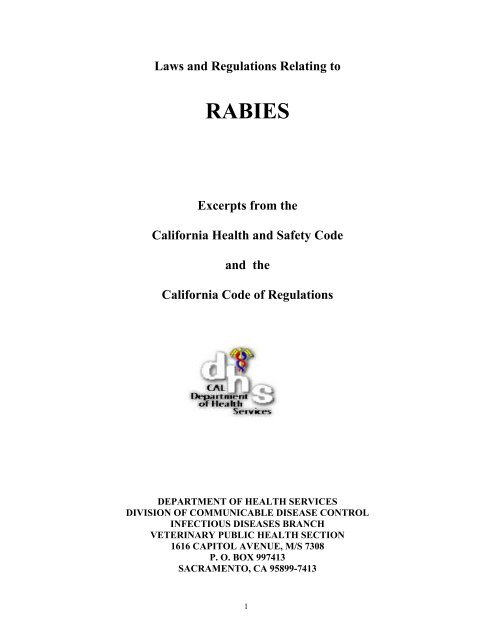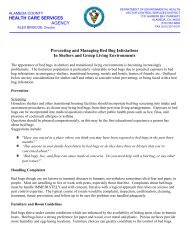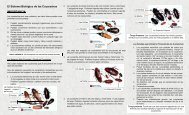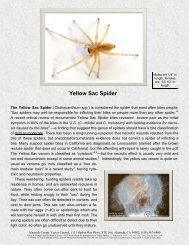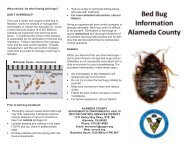Rabies Regulations - Vector Control Services - Alameda County
Rabies Regulations - Vector Control Services - Alameda County
Rabies Regulations - Vector Control Services - Alameda County
Create successful ePaper yourself
Turn your PDF publications into a flip-book with our unique Google optimized e-Paper software.
Laws and <strong>Regulations</strong> Relating toRABIESExcerpts from theCalifornia Health and Safety Codeand theCalifornia Code of <strong>Regulations</strong>DEPARTMENT OF HEALTH SERVICESDIVISION OF COMMUNICABLE DISEASE CONTROLINFECTIOUS DISEASES BRANCHVETERINARY PUBLIC HEALTH SECTION1616 CAPITOL AVENUE, M/S 7308P. O. BOX 997413SACRAMENTO, CA 95899-74131
California Health and Safety Code121575. "<strong>Rabies</strong>," as used in this chapter, includes rabies, and any other animal diseasedangerous to human beings that may be declared by the department as coming under this chapter.121580. "Quarantine," as used in this chapter, means the strict confinement, upon the privatepremises of the owner, under restraint by leash, closed cage, or paddock, of all animals specifiedin the order of the department.121585. "<strong>Rabies</strong> area" shall mean any area not less than a county as determined by the directorwithin a region where the existence of rabies constitutes a public health hazard, as found anddeclared by the director. A region shall be composed of two or more counties as determined bythe director. The status of an area as a rabies area shall terminate at the end of one year from thedate of the declaration unless, not earlier than two months prior to the end of the year, it is againdeclared to be a rabies area in the manner provided in this section. If however, the director atany time finds and declares that an area has ceased to be a rabies area its status shall terminateupon the date of the declaration.(Added by Stats. 1957. Ch. 1781.)121595. Whenever any case of rabies is reported as existing in any county or city, thedepartment shall make, or cause to be made, a preliminary investigation as to whether the diseaseexists, and as to the probable area of the state in which the population or animals are endangered.121600. If upon the investigation the department finds that rabies exists, a quarantine shall bedeclared against all animals as are designated in the quarantine order, and living within the areaspecified in the order.121605. Following the order of quarantine the department shall make or cause to be made athorough investigation as to the extent of the disease, the probable number of persons andanimals exposed, and the area found to be involved.121610. The department may substitute for the quarantine order regulations as may be deemedadequate for the control of the disease in each area.121615. All peace officers and boards of health shall carry out the provisions of this chapter.121620. During the period for which any quarantine order is in force any officer may kill or inhis or her discretion capture and hold for further action by the department any animal in aquarantine area, found on public highways, lands, and streets, or not held in restraint on privatepremises as specified in this chapter.121625. Any proper official within the meaning of this chapter may examine and enter upon allprivate premises for the enforcement of this chapter.121630. Except as provided in Sections 121705 and 121710, every person who possesses orholds any animal in violation of the provisions of this chapter is guilty of an infraction,punishable by a fine not exceeding one thousand dollars ($1,000).(Amended by Stats. 1971, Ch. 1379 and Stats. 1984, Ch. 697.)2
121635. For the purpose of providing funds to pay expenses incurred in connection with theeradication of rabies, the rabies treatment and eradication fund is continued in existence in eachcounty or city in this state.121640. All money collected for dog license taxes shall be deposited to the credit of this fundwith the treasurer of the county or city; but funds now collected from any dog tax may continueto be collected and used for other purposes specified by local ordinances.121645. Upon the determination by the department that rabies exists in any county or city, aspecial dog license tax shall immediately become effective, unless a dog tax is already in forcethe funds from which are available for the payment of expenditures in accordancewith this chapter.121650. This tax shall be levied as follows: An annual tax of one dollar and fifty cents ($1.50)for each male, two dollars and fifty cents ($2.50) for each female, and one dollar and fifty cents($1.50) for each neuter dog. It shall be collected by the proper authority at the same time and inthe same manner as other taxes are collected; except that at the first collection the proportion ofthe annual tax as corresponds to the number of months the tax has been in operation plus oneyear advance payment shall be collected.121655. After this dog license tax has been established in a county or city, it shall be continuedin force until an order has been issued by the department declaring that county, or the portion ofthat county as may be deemed advisable, to be free from rabies or further danger of its spread.121660. One half of all fines collected by any court or judge for violations of this chapter shallbe placed to the credit of the rabies treatment and eradication fund of the county or city wherethe violation occurred.121665. Whenever it becomes necessary in the judgment of the department, to enforce thischapter in any county or city, the department may institute special measures of control tosupplement the efforts of the local authorities in any county or city whose duties are specified inthis chapter.121670. All expenditures incurred in enforcing the special measures shall be proper chargesagainst the special fund referred to in this chapter, and shall be paid as they accrue by the properauthorities of each county or city where they have been incurred; but all expenditures that maybe incurred after the issuance of the order establishing the tax and before the first collection ofthe tax, shall be paid as they accrue from the general fund of the county or city.121675. All expenditures in excess of the balance of money in this fund shall likewise be paid asthey accrue from the general fund. All money thus expended from the general fund shall berepaid from the special fund when the collections from the tax have provided the money.121680. Notwithstanding any other provision of this chapter a guide dog serving a blind mastershall not be quarantined, in the absence of evidence that he or she has been exposed to rabies,unless his or her master fails:(a) To keep him or her safely confined to the premises of the master.3
(b) To keep him or her available for examination at all reasonable times.(Added by Stats. 1951, Ch. 1363.)121685. Notwithstanding any other provision of this chapter, a dog used by any state, county,city, or city and county law enforcement agency shall not be quarantined after biting any personif the bite occurred while the dog was being used for any law enforcement purpose. The lawenforcement agency shall make the dog available for examination at any reasonable time. Thelaw enforcement agency shall notify the local health officer if the dog exhibits any abnormalbehavior.(Added by Stats. 1976, Ch. 913.)121690. In rabies areas, all of the following shall apply:(a) Every dog owner, after his or her dog attains the age of four months, shall no less than onceevery two years secure a license for the dog as provided by ordinance of the responsible city, cityand county, or county. License fees shall be fixed by the responsible city, city and county, orcounty, at an amount not to exceed limitations otherwise prescribed by state law or city, city andcounty, or county charter.(b) Every dog owner, after his or her dog attains the age of four months, shall, at intervals oftime not more often than once a year, as may be prescribed by the department, procure itsvaccination by a licensed veterinarian with a canine antirabies vaccine approved by, and in amanner prescribed by, the department.(c) All dogs under four months of age shall be confined to the premises of, or kept underphysical restraint by, the owner, keeper, or harborer. Nothing in this chapter and Section 120435shall be construed to prevent the sale or transportation of a puppy four months old or younger.(d) Any dog in violation of this chapter and any additional provisions that may be prescribedby any local governing body shall be impounded, as provided by local ordinance.(e) It shall be the duty of the governing body of each city, city and county, or county tomaintain or provide for the maintenance of a pound system and a rabies control program for thepurpose of carrying out and enforcing this section.(f) It shall be the responsibility of each city, county, or city and county to provide dogvaccination clinics, or to arrange for dog vaccination at clinics operated by veterinary groups orassociations, held at strategic locations throughout each city, city and county, or county. Thevaccination and licensing procedures may be combined as a single operation in the clinics. Nocharge in excess of the actual cost shall be made for any one vaccination at a clinic. No owner ofa dog shall be required to have his or her dog vaccinated at a public clinic if the owner elects tohave the dog vaccinated by a licensed veterinarian of the owner's choice.All public clinics shall be required to operate under antiseptic immunization conditionscomparable to those used in the vaccination of human beings.(g) In addition to the authority provided in subdivision (a), the ordinance of the responsiblecity, city and county, or county may provide for the issuance of a license for a period not toexceed three years for dogs that have attained the age of 12 months or older and have beenvaccinated against rabies. The person to whom the license is issued pursuant to this subdivisionmay choose a license period as established by the governing body of up to one, two, or threeyears. However, when issuing a license pursuant to this subdivision, the license period shall notextend beyond the remaining period of validity for the current rabies vaccination. A dog ownerwho complies with this subdivision shall be deemed to have complied with the requirements ofsubdivision (a).(Amended by Stats. 1970, Ch. 70 and Stats. 1986, ch. 664.)4
(h) All information obtained from a dog owner by compliance with this chapter is confidentialto the dog owner and proprietary to the veterinarian. This information shall not be used,distributed, or released for any purpose, except to ensure compliance with existing federal, state,county, or city laws or regulations.121695. Nothing in this chapter and Section 120435 is intended or shall be construed to limit thepower of any city, city and county, or county in its authority in the exercise of its police power orin the exercise of its power under any other provisions of law to enact more stringentrequirements, to regulate and control dogs within the boundaries of its jurisdiction.(Added by Stats. 1957, Ch. 1781.)121700. <strong>Rabies</strong> vaccines for animal use shall not be supplied to other than a veterinary biologicsupply firm, a person licensed to practice veterinary medicine under Chapter 11 (commencingwith Section 4800) of Division 2 of the Business and Professions Code, or a public agency.(Added by Stats. 1965, Ch. 599.)121705. Any person who willfully conceals information about the location or ownership of ananimal subject to rabies, that has bitten or otherwise exposed a person to rabies, with the intent toprevent the quarantine or isolation of that animal by the local health officer is guilty of amisdemeanor.Any person who violates this section is guilty of a misdemeanor.(Added by Stats. 1984, Ch. 697.)121710. Any person who, after notice, violates any order of a local health officer concerning theisolation or quarantine of an animal of a species subject to rabies, that has bitten or otherwiseexposed a person to rabies or who, after that order, fails to produce the animal upon demand ofthe local health officer, is guilty of a misdemeanor, punishable by imprisonment in the countyjail for a period not to exceed one year, or by fine of not less than one hundred dollars ($100),nor more than one thousand dollars ($1,000) per day of violation, or by both fine andimprisonment.(Added by Stats. 1984, Ch. 697.)5
Title 17, California Code of <strong>Regulations</strong>2606. <strong>Rabies</strong>, Animal.(a) Reporting. Any person having knowledge of the whereabouts of an animal known to haveor suspected of having rabies shall report the facts immediately to the local health officer. Thehealth officer shall likewise be notified of any person or animal bitten by a rabid or suspectedrabid animal.In those areas declared by the Director of the State Department of Health <strong>Services</strong> to be rabiesareas (See Section 121585, California Health and Safety Code) the local health officer shall benotified when any person is bitten by an animal of a species subject to rabies, whether or not theanimal is suspected of having rabies.(b) Isolation. Any rabid animal, clinically suspected rabid animal, or biting animal shall beisolated in strict confinement as follows:(1) Isolation of Rabid Animals or Clinically Suspected Rabid Animals. Any rabid animal orclinically suspected rabid animal shall be isolated in strict confinement under proper care andunder the observation of a licensed veterinarian, in a pound, veterinary hospital, or otheradequate facility in a manner approved by the local health officer, except where suchresponsibility has been delegated to a comparable officer by the governing body, and shall not bekilled or released for at least 10 days after the onset of symptoms suggestive of rabies, with theexception that such animals may be sacrificed with permission of the local health officer for thepurpose of laboratory examination for rabies using the fluorescent rabies antibody (FRA) test inan approved public health laboratory.(2) Isolation of Biting Animals. At the discretion of the local health officer any animal whichbites or otherwise exposes a person shall be isolated in strict confinement in a place and mannerapproved by the local health officer and observed for at least 14 days (dogs and cats 10 days)after the day of infliction of the bite, with the exception that the following alternative to the 10day isolation of dogs and cats is permitted -- dogs or cats which have been isolated in strictconfinement under proper care and under observation of a licensed veterinarian, in a pound,veterinary hospital, or other adequate facility in a manner approved by the local health officer,may be released from isolation by the local health officer after five days of veterinaryobservation if upon conducting a thorough physical examination on the fifth day or more afterinfliction of the bite, the observing veterinarian certifies that there are no clinical signs orsymptoms of any disease. Notwithstanding the foregoing provisions, a local health officer mayauthorize, with permission of the owner and other legal restrictions permitting, the euthanasia ofa biting animal for the purpose of laboratory examination for rabies using the fluorescent rabiesantibody (FRA) test in an approved public health laboratory.(3) Isolation of Biting Animals in Officially Declared <strong>Rabies</strong> Areas. In officially declaredrabies areas (see Section 121585, California Health and Safety Code) the isolation described inparagraph (2) above shall be mandatory for any animal of a species subject to rabies that hasbitten or otherwise exposed a person, with the exception of rodents (members of the orderRodentia) and rabbits and hares (members of the order Lagomorpha).(4) Laboratory Examination of Rabid Animals, Clinically Suspected Rabid Animals orBiting Animals Which Die or Have Been Killed. If any rabid animal, clinically suspected rabidanimal or biting animal dies or has been killed, adequate specimens shall be obtained andexamined in a public health laboratory approved by the department. No person shall destroy orallow to be destroyed the brain of an animal of a species subject to rabies that has bitten orotherwise exposed a person before the destruction of such brain has been authorized by the localhealth department; provided, however, that the provisions of this paragraph (4) shall not apply to6
odents (members of the order Rodentia) and rabbits or hares (members of the orderLagomorpha).(c) Animal Contacts. Any animal of a species subject to rabies which has been bitten by aknown rabid or suspected rabid animal or has been in intimate contact with a rabid or suspectedrabid animal shall be quarantined in a place and manner approved by the local health officer,except where such responsibility has been delegated to a comparable officer by the localgoverning body, for a period of six months or destroyed, with the exception that the followingalternatives are permitted in the case of dogs and cats as follows:(1) If a dog over one year of age has been vaccinated against rabies within 36 months but notless than 30 days with a rabies vaccine of a type approved by the Department for a maximumimmunity duration of at least 36 months, the dog may be revaccinated immediately (within 48hours) in a manner prescribed by the Department and quarantined in a place and mannerapproved by the local health officer for a period of 30 days following revaccination.(2) If a dog under one year of age has been vaccinated against rabies within 12 months but notless than 30 days with a rabies vaccine of a type approved by the Department, the dog may berevaccinated immediately (within 48 hours) in a manner prescribed by the Department andquarantined in a place and a manner approved by the local health officer for a period of 30 days.(3) If a cat has been vaccinated within one year but not less than 30 days with an annual typefeline rabies vaccine or if a cat has been vaccinated under one year of age with a 36-month typeof feline rabies vaccine within 12 months but not less than 30 days, the cat may be revaccinatedimmediately (within 48 hours) in a manner prescribed by the Department and quarantined in aplace and manner approved by the local health officer for a period of 30 days followingrevaccination.(4) If a cat over one year of age has been vaccinated against rabies and has been vaccinatedwithin 36 months and more than 30 days with a 36-month type feline rabies vaccine, the cat maybe revaccinated immediately (within 48 hours) in a manner prescribed by the Department andquarantined in a place and manner approved by a local health officer for a 30-day periodfollowing revaccination.NOTEAuthority cited: Sections 100275, 121610 and 120130, Health and Safety Code. Reference: Sections 121580,121600, 121610, 121620 and 120130, Health and Safety Code.HISTORY1. Amendment filed 5-5-71; effective thirtieth day thereafter (Register 71, No.19). For prior history see Register 65,No. 8.2. Amendment of subsection (c) filed 5-20-77; effective thirtieth day thereafter (Register 77, No. 21).3. Amendment filed 1-27-86; effective thirtieth day thereafter (Register 86, No. 5).2606.2. <strong>Rabies</strong> Quarantine.If rabies is known to exist within an area, the local health officer may establish a rabiesquarantine and shall define the boundaries of the quarantine area and specify the animals subjectto quarantine, and all such animals within the quarantined area shall be kept in strict confinementupon the private premises of the owner, keeper or harborer at all times until the quarantine isterminated by the local health officer.NOTEAuthority cited: Sections 100110, 100275, 121575-121710 and 120435 Health and Safety Code.HISTORY1. New section filed 12-19-57; effective thirtieth day thereafter (Register 57, No. 22).7
2. Amendment filed 5-5-71; effective thirtieth day thereafter (Register 71, No.19).2606.4. Officially Declared <strong>Rabies</strong> Areas.(a) Administration and Enforcement. For purposes of administration and enforcement ofSection 121690, California Health and Safety Code, in officially declared rabies areas, thefollowing shall apply:(1) Licensing and Vaccination Procedure. The vaccination of dogs four months of age orolder as required by subdivision (b), Section 121690, California Health and Safety Code, shall beheld a requisite to licensing as required under subdivision (a) therein. Completion of thelicensing procedure consists of issuance of a license tag or a vaccination tag bearing the licensedata and shall be carried out only after presentation of a current valid official vaccinationcertificate. Current copies of the Compendium of Canine <strong>Rabies</strong> Vaccines approved by theDepartment, together with the maximum immunity duration periods prescribed by theDepartment for each type product, are available upon request from the Veterinary Public HealthUnit, Infectious Disease Section, California Department of Health <strong>Services</strong>, 2151 Berkeley Way,Berkeley, California, 94704, telephone (415) 540-2391.(2) Vaccination Certificates. Official vaccination certificates must show:(A) the name, address and telephone number of the dog's owner;(B) the description of the dog, including breed, color, age, and sex;(C) the date of immunization;(D) the type of rabies vaccine administered;(E) the name of the manufacturer; and(F) the lot number of the vaccine used.Such certificates shall bear the signature of the veterinarian administering the vaccine or asignature authorized by him, and in addition such certificate shall be stamped, printed, or typedwith his name, address and telephone number for legibility, with the exception that at dogvaccination clinics conducted pursuant to Section 121690(f) of the Health and Safety Code,vaccination certificates approved by the local health officer may be used provided that thespecific clinic is identified upon the vaccination certificate and records are maintained containingthe information specified under items (E) and (F) above.(3) Interval Permitted for Procurement of License. The vaccination of dogs four months ofage against rabies as required under subdivision (b), Section 121690, California Health andSafety Code, and the license required by subdivision (a) of said section shall be procured notlater than 30 days after the dog attains the age of four months. The license renewal shall beprocured not later than 60 days after expiration of the previously issued license.(4) <strong>Rabies</strong> <strong>Control</strong> Activities Reporting. During such time as a county is under officialdeclaration as a rabies area, each local official responsible for the various phases of local dog orrabies control within each city, county and city or cities, or county shall make quarterly rabiescontrol activities reports to and on forms furnished by the Department. Such reports shall besubmitted to the Department by the local officials responsible for the various phases of local dogor rabies control through the local health officer so as to reach the Department not later than 30days following each quarter.(b) Vaccination of Dogs Against <strong>Rabies</strong>. Dogs shall be considered to be properly vaccinatedfor the purposes of Section 121690, California Health and Safety Code, when injected at fourmonths of age or older with an approved canine rabies vaccine and revaccinated in accordancewith the following conditions:8
(1) Primary Immunization. Primary immunization shall be defined as the initial inoculation ofan approved canine rabies vaccine administered to young dogs between the ages of 4 to 12months.(2) Minimum Age for <strong>Rabies</strong> Vaccination. The minimum age for which rabies immunizationof dogs shall be accepted for purposes of dog-owner compliance with requirements for rabiesvaccination and for purposes of issuance of dog licenses (See Section 2606.4(a)(1)) is 4 months.(3) Revaccination Intervals. Dogs shall be revaccinated one year (12 months) after theprimary immunization with an approved type of rabies vaccine. Dogs receiving vaccination afterprimary immunization or any dog receiving its initial rabies vaccination over 12 months of ageshall be revaccinated thereafter at least once every three years (36 months) with an approvedtype rabies vaccine.(c) Issuance of Dog Licenses. In no instances shall a dog license be issued for a period beyondthe date upon which revaccination is due except, following primary immunization in a localjurisdiction which is on a fixed one-year licensing period, a license may be issued for a periodbeyond the revaccination date if early revaccination cannot be required in accordance withsubdivision (d).(d) Notwithstanding the rabies revaccination intervals specified in Section 2606.4(b)(3) above,local authorities may require revaccination prior to issuance of a license provided thatrevaccination against rabies in no instance shall be required sooner than one year (12 months)following a primary immunization or sooner than 2 years (24 months) following a vaccination ofdogs vaccinated over one year (12 months) of age.NOTEAuthority cited: Sections 100275 and 121610, Health and Safety Code. Reference: Sections 121610 and 121690,Health and Safety Code.HISTORY1. New section filed 12-19-57; effective thirtieth day thereafter (Register 57, No. 22).2. Amendment filed 5-5-71; effective thirtieth day thereafter (Register 71, No. 19).3. Amendment filed 5-20-77; effective thirtieth day thereafter (Register 77, No. 21).4. Amendment filed 1-27-86; effective thirtieth day thereafter (Register 86, No. 5).9


